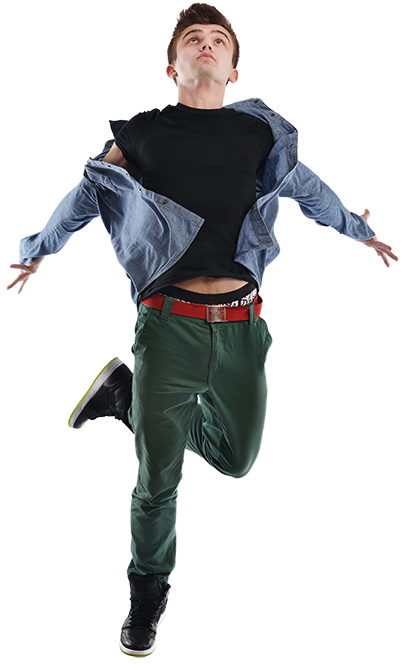“Let me tell you what I think of bicycling. I think it has done more to emancipate women than anything else in the world. It gives women a feeling of freedom and self-reliance. I stand and rejoice every time I see a woman ride by on a wheel…the picture of free, untrammeled womanhood.” Susan B. Anthony
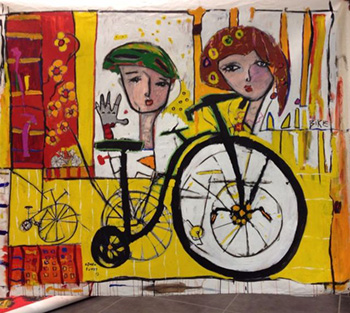
ARTCYCLE: Bikes Become Art - Astolfo Funes.
Bicycles and art are both vehicles of movement and escape. The beloved two-wheeled instruments of transport, recreation, and joy provide a tangible escape measurable in the distance traveled down roads. With art, the escape is a construct of the imagination. The transmutation of painful emotional energy into a thing of beauty is characteristic of great, transformative art, which provides a beneficial, healing service to humanity.
Since the bicycle movement has been growing in the Magic City through events like Critical Mass and activists organizations including the Magic City Bicycle Collective (magiccitybike.com), Emerge (emergemiami.com) and H.E.R (Help Earth Ride) (helpearthride.com), people have been expressing the phenomenon through art. An innovative exhibition group, ARTcycle (art-cycle.org), is exploring the relationship between art and bicycles in Miami. Converging the bike scene with the art scene, ARTcycle is promoting tolerance, respect, and awareness for cyclists; ARTcycle is currently hosting a popular must-see exhibition called Bikes Become Art. Bikes Become Art will be on display at the Coral Gables Museum until Feb. 23.
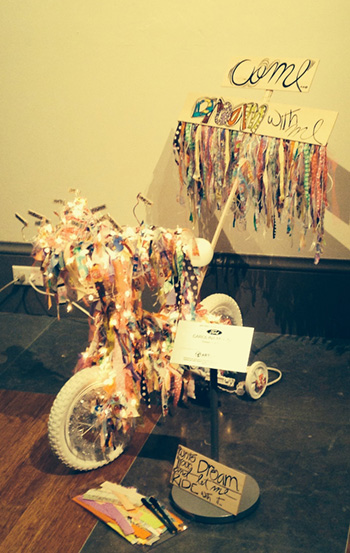
ARTCYCLE: Bikes Become Art - Carolina Molina.
One artist emerging from the bike movement is Vera Arias, (veraarias.tumblr.com) who is also a graphic designer, bicycle mechanic and H.E.R bicycle activist. For Arias bicycles and art are interconnected like the spokes on wheels. Her personal association with art and bicycles originated in a rough childhood as the daughter of illegal immigrants facing poverty, mental illness and abuse.
“The first time I saw a bicycle, I knew I was going to be an artist,” she claims. The architecture of the spoked vehicles first moved Arias to draw as a young girl after seeing her cousin fixing a bicycle. Moreover Arias recalls physical abuse at the hands of her mentally-ill mother after she disobeyed her demands to not ride the bicycle far from home. So, not only does Arias subconsciously relate bicycles to her artistic awakening, but she also associates the pedaled recreational vehicles with childhood emotional trauma.
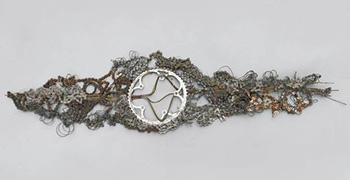
ARTCYCLE: Bikes Become Art - Lucinda Linderman.
Arias takes discarded parts from bicycles and creates sculptures resembling the circular anatomy of the traveling instrument. Some of her pieces serve functions, such as holders and racks for bikes. Moreover, creating cool art from remnants left unwanted is a therapeutic activity Arias relates to growing up without many resources.
While art has helped her emotionally, art also literally helped Arias escape a difficult childhood. She won a full scholarship to the prestigious School of the Museum of Fine Arts in Boston. Vera Arias was also the NFAA Gold Winner in Visual Arts and Presidential Scholar in the Arts in 2004 while a student at New World School of the Arts. Arias also describes her art as a vehicle for healing. Through her work, she transmutes negative emotions onto a blank slate whereby anything is possible. The process is a creative alchemy that produces a calming effect and a work of art from emotional, mental overstimulation. I recently talked to Vera Arias about her life and art.
What’s the biggest challenge you’ve faced as an immigrant?
One of the biggest challenges growing up as an immigrant was growing up with my mother who had severe epilepsy. My mother loved me and did the best she could to raise me and I could tell how hard she worked to keep me happy. It wasn’t always easy being with her dealing with her mental condition and constantly being sick.
Our lives always revolved around getting the help she required to make her feel better physically, emotionally and mentally. When you are undocumented in this country, you are not entitled to healthcare. How are you supposed to get help when the system is denying you the right to feel better?
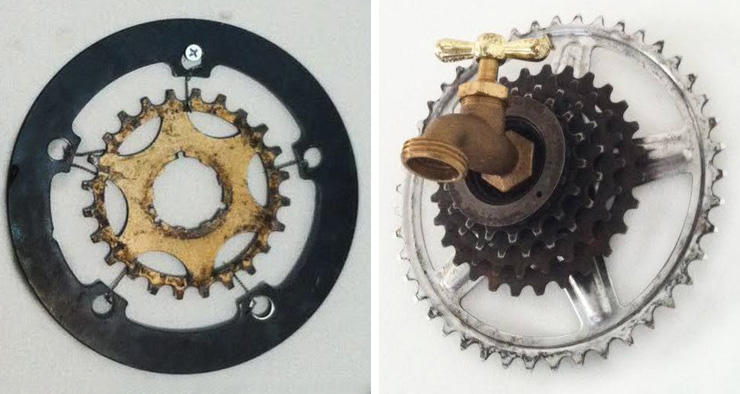
Vera Arias’ Bike Sculptures.
There is an underground pharmaceutical world in undocumented neighborhoods in Miami that people are not aware of. These facilities are constantly raided by immigration so there is apprehension at all times when buying your medications secretively.
As a kid experiencing this was very traumatizing. Nonetheless, in some weird way I learned to externalize these feelings and become extremely passive aggressive. This is something that is very unhealthy for any ten-year old child to go through. I can’t reclaim ever letting my self feel any type of emotion in a healthy way. When I felt as if I could burst like a ticking bomb of repression from holding it all in I would express in an inappropriate way.
I am extremely thankful that the only healthy outlet I had throughout my childhood was art. I believe that the material that is used for art is not limited to anything because anything can be rendered into a form of expression. The materials that I could relate to have always been trash and recycled items left behind. I remember going on long walks and picking up rusty pieces of metal and decayed wood as my gathering for art materials. Since I have grown up in a world where you really have to be resourceful and creative to find a solutions to problems that seem impossible. These materials I chose for my art are essentially a symbolism of my undocumented family.
I was very fortunate to have been born in this country, which is why as a child I gave my self such a hard time letting myself experience happiness. This was a constant guilt and product of always being oppressed.
What do you love about bicycles?
The anatomy of the bicycle has a beautiful construction of gears and wheels that turn effortlessly through the motion of your legs going up and down. Every bicycle is different and each has its own set of components that make it unique in its own way.
One of my most favorite parts of the bicycle is the chain ring. The chain ring is the circular part of the bicycle that is connected to the crank, which is connected to the pedals. The chain ring determines how fast you go depending on how many teeth there are in its outer shape. There are tons of sizes and shapes and each one reminds me of a mandala each in its own. I love the pattern and symmetry. It reminds me a lot of scared geometry. Scared geometry is interconnectedness, inseparability and union, which provide us with a continuous reminder of our relationship to the universe. The blueprint for the mind of the sacred foundation of all things created. Essentially the geometry is symbolically related to the chain ring providing a source of symmetry that connects the cyclist to the bicycle in perfect form.
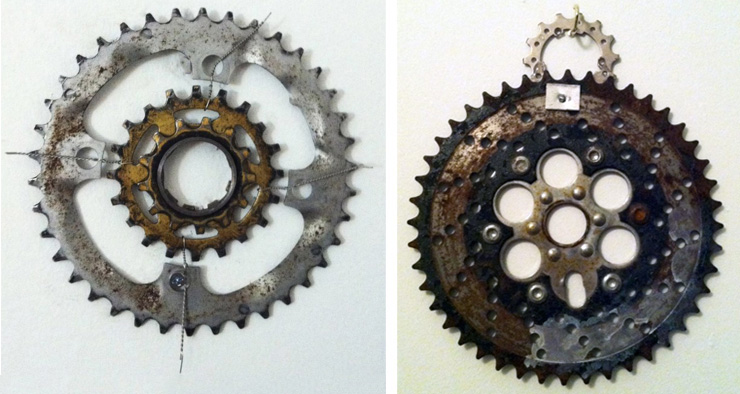
Vera Arias’ Bike Sculptures.
What is it about riding bicycles that is special to you?
The bicycle symbolizes the tangible object that keeps me focused. It serves sustainability and health. It keeps your body constantly active, increasing the endorphins in your brain.
It literally makes me happy and it’s even better when I ride with my friends. Albert Einstein describes it best “life is like riding a bicycle. To keep your balance you must keep moving.” I feel the bicycle has not just balanced me but has also grounded me in all aspects of my life.
It is a therapy that keeps me concentrated and focused.
We all experience bad days and instead of escaping with drugs and alcohol I use my bicycle. I go on long bicycle rides throughout the city. These times I spend riding along the streets of my neighborhood where I really do become closer to my city and my self in many ways.
You realize that instead of swaying off into a dark place you can transform your attitude and find your way into the positivity into your true self. It really feels like riding a bike keeps me in the now, the present moment, acting as a form of meditation.
Meditation is a ritual I do every morning and the bicycle is that exercise that keeps me in a mode of discipline forming responsibility and in the achievement of my goal.
What do you hope to achieve through your bicycle art?
I hope to be able to inspire others and show them that through imagination and creativity we can manifest our dreams and transcend trauma. We can transform ourselves, find creative solutions through our everyday living.
I also want to bring more advocacy of alternative public transportation to our community. You can get anywhere within the city of Miami in 30 minutes on bicycle. Through my bicycle art I can have more conversations, communications and dialogue with my community which will inspire people to ride more and drive less.
What are your ultimate goals as an artist and cyclist/bicycle activist in H.E.R?
Honestly, my ultimate goal is to live out of my passion and live a life of sustainability through my art. To wake up in the morning, ride my bicycle to my studio and work on my art all day. Art is my sacred space.
I believe this is my path. Enhancing our community in a way of health, sustainability and community, generating a sense of love and awareness. Expression does involve creativity being in that personal experience through the people that have inspired me. The connections and interactions we build as we collaborate.




